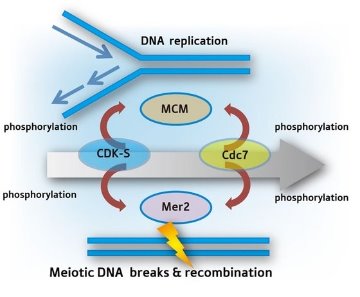May 30, 2008 Research Highlight Biology
Keeping everything in order
Investigators may have uncovered a molecular ‘switch’ that ensures that processes relating to cell division occur in the proper sequence
 Figure 1: The protein kinases CDK-S and Cdc7 play an important role in regulating two key steps in meiotic cell division, mediating DNA replication through the phosphorylation of the MCM proteins, and controlling DSB formation and chromosomal recombination via phosphorylation of Mer2.
Figure 1: The protein kinases CDK-S and Cdc7 play an important role in regulating two key steps in meiotic cell division, mediating DNA replication through the phosphorylation of the MCM proteins, and controlling DSB formation and chromosomal recombination via phosphorylation of Mer2.
Meiosis is a complex multi-step process by which certain cells divide to yield specialized cells called gametes, which contain half the normal cellular complement of genetic material and act as the vehicles for sexual reproduction.
Prior to division, the chromosomes replicate and align in sets. At this stage, sister chromosomes will occasionally swap segments, a process called recombination that introduces an additional measure of genetic diversity prior to cell division. Recombination requires the introduction of double-stranded breaks (DSBs) in the DNA, a tightly regulated process mediated by a handful of specialized proteins.
Previous research in yeast has demonstrated that the protein kinase Cdc7/Hsk1, an important factor in DNA replication, is also involved in DSB formation1. Now, one author from this study, Kunihiro Ohta of the RIKEN Advanced Science Institute (formerly the Discovery Research Institute) in Wako, has followed up with a study that explores more closely the mechanism of Cdc7’s involvement in this process2.
Ohta’s team worked with a mutant strain of the yeast species Saccharomyces cerevisiae in which Cdc7 expression is eliminated, but DNA replication is not affected. They observed a complete absence of meiotic DSBs in this strain, as well as altered expression in genes known to act in the middle and late stages of meiosis.
One component of the DSB formation complex, Mer2, is known to be phosphorylated by CDK, another cell-cycle-associated protein kinase. Based on this information, Ohta and colleagues investigated whether Cdc7 also phosphorylates Mer2, and identified several Cdc7-specific phosphorylation sites.
These modifications appear to be essential triggers for recombination, and yeast strains expressing Mer2 variants in which these phosphorylation sites had been eliminated exhibited defects in meiotic division and reduced spore viability. DSB formation and recombination were both sharply reduced in these mutant strains.
These findings are a valuable step toward understanding the regulatory mechanisms that ensure that the various steps of meiotic division occur in the proper sequence. “Many researchers have thought replication and recombination are tightly coupled in meiosis—our results suggest a molecular mechanism for such linkage via a master regulator,” explains Ohta. In such a scenario, the Mer2 phosphorylation by Cdc7 and CDK would act as a switch, establishing a state in which DSB formation and recombination can take place once DNA replication is complete (Fig. 1).
Ohta’s team is now investigating the details of this phosphorylation, and attempting to clarify the specific events in early meiosis that trigger CDK- and Cdc7-mediated activation of Mer2.
References
- 1. Ogino, K., Hirota, K., Matsumoto, S., Takeda, T., Ohta, K., Arai, K. & Masai, H. Hsk1 kinase is required for induction of meiotic dsDNA breaks without involving checkpoint kinases in fission yeast. Proceedings of the National Academy of Sciences USA 103, 8131–8136 (2006). doi: 10.1073/pnas.0602498103
- 2. Sasanuma, H., Hirota, K., Fukuda, T., Kakusho, N., Kugou, K., Kawasaki, Y., Shibata, T., Masai, H. & Ohta, K. Cdc7-dependent phosphorylation of Mer2 facilitates initiation of yeast meiotic recombination. Genes & Development 22, 398–410 (2008). doi: 10.1101/gad.1626408
